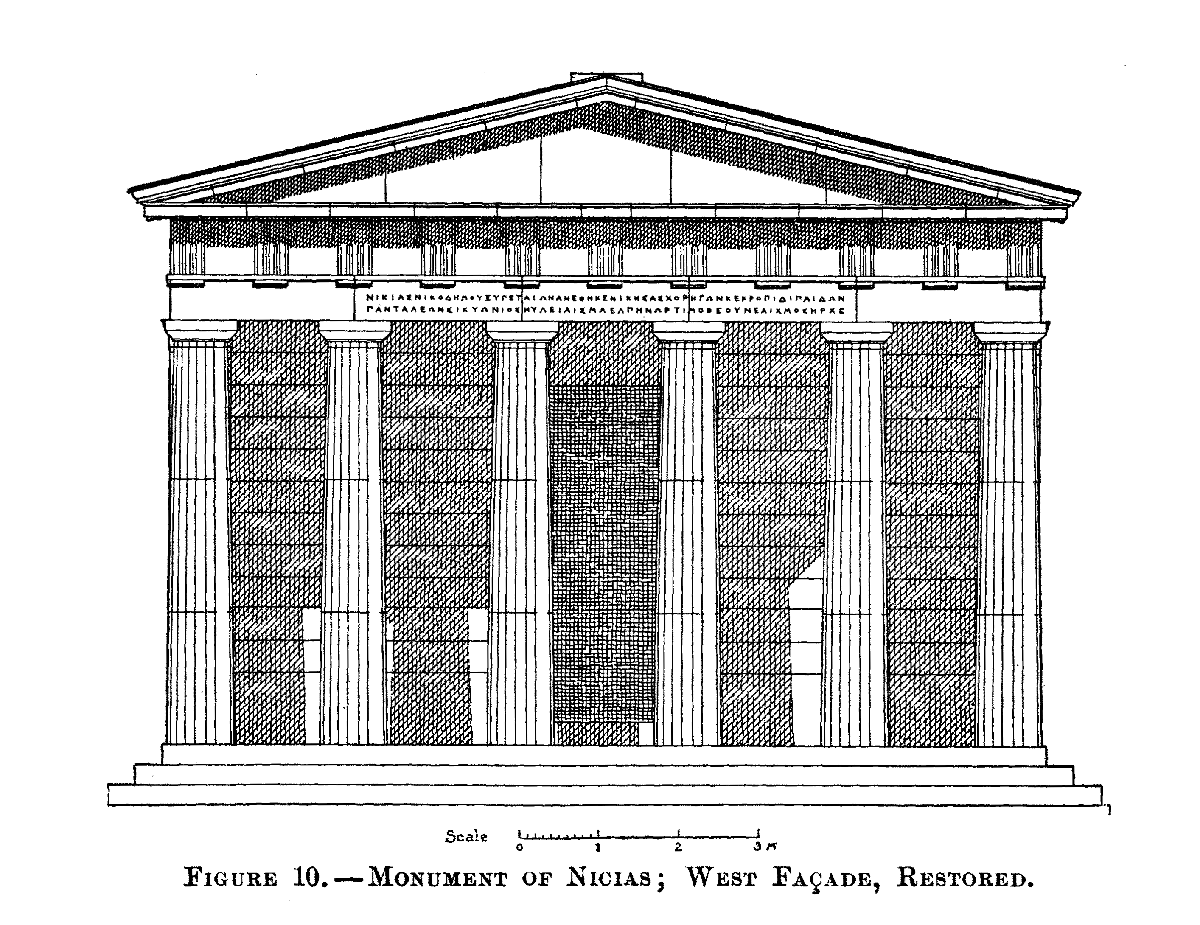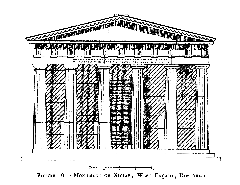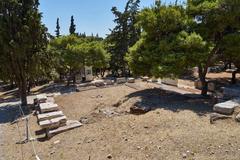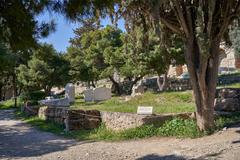
Visiting the Monument of Nikias in Athens, Greece: Complete Guide
Date: 15/06/2025
Introduction
Nestled on the southern slope of Athens’ Acropolis, the Monument of Nikias stands as a compelling testament to the cultural vitality, civic pride, and artistic achievement of Classical Athens. Erected in 320–319 BCE, this choragic monument was built to commemorate Nikias, son of Nikodemos, following his victory as a choregos (chorus sponsor) in a youth dithyrambic contest during the Great Dionysia festival—an event central to the worship of Dionysus, god of theatre and wine. Though only its foundations and a few fragments endure today, the monument’s story is interwoven with the city’s layered history, including the repurposing of its stones for the Beulé Gate in the 3rd century CE. This guide provides a comprehensive overview of the Monument of Nikias, combining historical context, architectural insights, practical visitor information, and tips for an enriching experience among Athens’ most storied ruins (arvip.gr; Trek Zone; Athens Tourist Information).
Table of Contents
- Introduction
- Historical Context: Choragic Monuments and Athenian Society
- Architectural Features and Artistic Significance
- Visitor Information: Hours, Tickets, Accessibility, and Tips
- Nearby Attractions and Suggested Itineraries
- Frequently Asked Questions (FAQ)
- Conclusion and Recommendations
- References and Official Sources
Historical Context: Choragic Monuments and Athenian Society
The Role of the Choregos in Classical Athens
In the democratic system of Classical Athens, the choregos was a wealthy citizen who undertook the sponsorship of choruses in dramatic and musical competitions, most notably during the Great Dionysia festival. This sponsorship was both a civic duty and a means for elite individuals to demonstrate their public generosity and gain social prestige. Nikias, son of Nikodemos from the deme of Xypete, won the youth dithyrambic contest at the Great Dionysia of 320/19 BCE, and his monument stands as proof of his contribution to the city’s cultural life (arvip.gr).
Urban and Social Significance
The Monument of Nikias was strategically placed along Tripodon Street, between the Theatre of Dionysus and the Stoa of Eumenes, an area rich in choragic dedications. These monuments evolved from simple tripods on columns to more elaborate temple-like structures, mirroring the increasing ambitions and rivalry among Athens’ elite citizens. Their construction required substantial expense, highlighting the intertwining of personal wealth, civic duty, and public recognition in Athenian society.
Legacy and Later History
Over centuries, the monument’s stones were dismantled and used in later structures, most notably the Beulé Gate, reflecting the city’s evolving needs and the layering of its historical landscape. Today, the monument’s foundations and some architectural fragments remain visible, offering valuable archaeological insights and a tangible connection to Athens’ ancient past (Trek Zone).
Architectural Features and Artistic Significance
Design, Materials, and Craftsmanship
The Monument of Nikias was designed as a naiskos (small temple), featuring a rectangular plan with a square cella and a hexastyle (six-column) Doric façade. Built from local limestone and Pentelic marble, its refined materials and craftsmanship underscored its grandeur and the importance of the dedication.
The Tripod and Decorative Elements
The monument originally supported a bronze tripod—the prize for victorious choregoi—on an elevated pedestal, making it highly visible to festival crowds. Decorative moldings, inscriptions, and sculptural details adorned the structure, with an inscription on the façade recording Nikias’s name, his father, his deme, and his victory.
Comparative and Lasting Impact
Among choragic monuments, Nikias’s stands out for its scale and classical Doric design, contrasting with the more ornate Monument of Lysicrates. Its temple-like form influenced later commemorative architecture and neoclassical revivals (Adequate Travel).
Visitor Information: Hours, Tickets, Accessibility, and Tips
Location and How to Get There
The Monument of Nikias is situated between the Theatre of Dionysus and the Stoa of Eumenes on the Acropolis’s southern slope. Access is via the main Acropolis archaeological zone.
- By Metro: Akropoli station (Line 2), 10-minute walk to the entrance.
- By Bus: Stops near the Acropolis Museum.
- On Foot: Easily incorporated into a walking tour of the Acropolis and adjacent landmarks.
Visiting Hours
- Summer (April–October): 8:00 AM – 8:00 PM
- Winter (November–March): 8:00 AM – 5:00 PM
- Last entry is 30 minutes before closing. Hours may vary on holidays (Athens Tourist Information).
Tickets and Admission
- Entry to the Monument of Nikias is included in the Acropolis ticket.
- Standard adult ticket: €20 (high season), €10 (low season). Reduced rates for students, seniors, and children.
- Combined ticket: €30, valid for multiple archaeological sites over five days.
- Purchase tickets online or at the entrance; advance booking is recommended during peak periods.
Accessibility
- The Acropolis terrain is steep and uneven; some accessible routes exist, but access to the monument’s foundations may be limited for wheelchair users (Accessible Athens).
- Facilities include public restrooms, drinking fountains, and shaded areas near main entrances.
Visitor Tips
- Wear sturdy, non-slip footwear and dress for the weather (light clothing, sun protection in summer; rain jacket in winter).
- Arrive early or late in the day for cooler temperatures and fewer crowds.
- Photography is permitted, but tripods require permission. Morning and late afternoon offer the best light.
- Remain vigilant with valuables and respect all archaeological remains.
Nearby Attractions and Suggested Itineraries
- Theatre of Dionysus: Adjacent to the monument, a must-see for theatre and history enthusiasts.
- Choragic Monument of Thrasyllos: Located nearby, offering comparative insight into choragic dedications.
- Stoa of Eumenes: Historic walkway with stunning views.
- Acropolis Museum: Modern exhibits contextualize the Acropolis’s monuments.
- Suggested walking route: Theatre of Dionysus → Monument of Nikias → Stoa of Eumenes → Acropolis summit.
Frequently Asked Questions (FAQ)
Q: What are the Monument of Nikias opening hours?
A: The Acropolis site, including the monument, is open daily from 8:00 AM to 8:00 PM in summer and 8:00 AM to 5:00 PM in winter. Last entry 30 minutes before closing.
Q: How much are tickets?
A: €20 for adults (high season), €10 in low season; reduced rates for eligible visitors. Combined tickets are available.
Q: Is the monument accessible for people with mobility issues?
A: The terrain is uneven and can be challenging; accessible routes are provided but may not reach the monument’s foundation.
Q: Are guided tours available?
A: Yes, many Acropolis tours include the Monument of Nikias. Audio guides and mobile apps such as Audiala are recommended for deeper insights.
Q: Can I take photos at the monument?
A: Yes, photography is allowed. Use of tripods or drones requires approval.
Conclusion and Recommendations
The Monument of Nikias, though largely in ruins, remains a vital emblem of Athens’ ancient theatrical and civic heritage. Its enduring presence within the UNESCO World Heritage Acropolis complex provides visitors with a meaningful connection to the city’s storied past. With clear signage, informative audio guides, and the proximity of world-class sites like the Theatre of Dionysus and the Acropolis Museum, a visit to the Monument of Nikias is both educational and inspiring. Plan your visit for early morning or late afternoon, use official resources for the latest updates, and respect the site to help preserve its legacy for future generations.
Enhance your visit by downloading the Audiala app for expert audio guides, explore interactive maps, and join the community on social media for updates and insider tips. Discover more about Athens’ historical sites and create your own memorable journey through the city’s ancient wonders!
References and Official Sources
- Monument of Nikias: Visiting Hours, Tickets, and Historical Insights at Athens’ Iconic Site, 2025, ARVIP
- Choragic Monument of Nikias in Athens: History, Visiting Hours, and Travel Guide, 2025, Trek Zone
- Visitor Guide to the Monument of Nikias: Visiting Hours, Tickets, and Athens Historical Sites, 2025, Athens Tourist Information
- Adequate Travel: The Choregic Monument of Nikias in Greece – Overview, Prominent Features, History, Interesting Facts
- Accessible Athens
- The Invisible Tourist: Athens Travel Tips
- All Events in Athens (June)






















































































